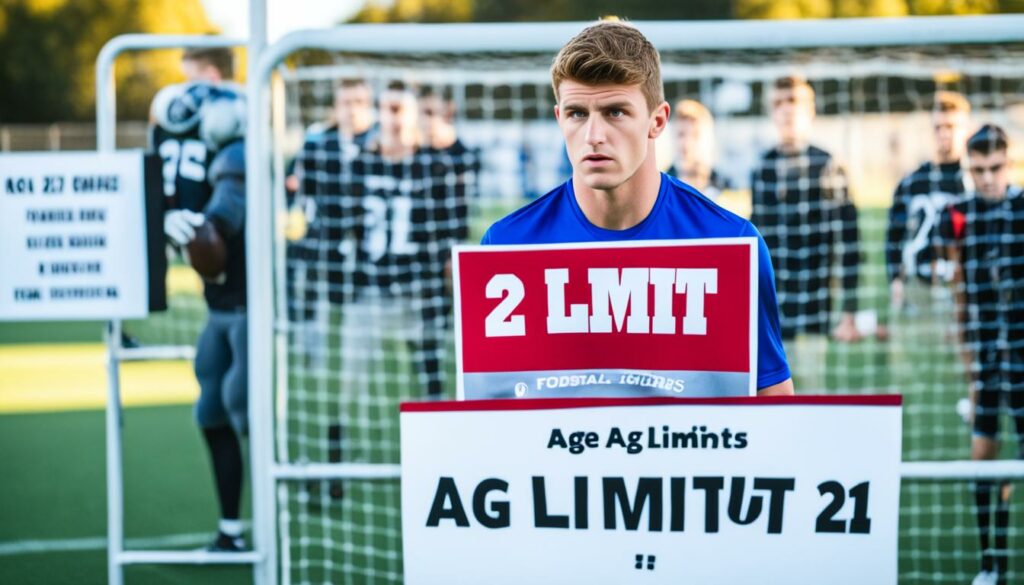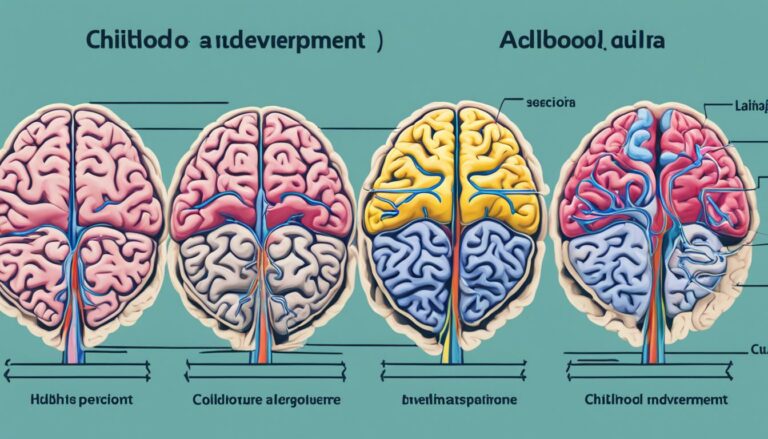Teens in Pro Sports: Too Young or Just Right?
When it comes to youth athletes pursuing a professional career in sports, the question of whether they are too young to go pro is a topic of debate. Professional sports leagues around the world have age requirements in place to ensure the physical and mental readiness of young athletes. Each sport has its own policies regarding the minimum age for players.
The NFL, for example, requires athletes to be at least three years removed from high school, usually 21 or 20 years old. The NBA sets the age requirement at 19, while the NHL allows players to enter the professional league at 18 years old. Major League Baseball has different minimum ages for U.S. and international players, with U.S. players needing to be 18 and international players allowed to sign at 17.
Key Takeaways:
- Professional sports leagues have age requirements in place to determine the readiness of young athletes.
- The NFL, NBA, NHL, and MLB all have different minimum age policies for players.
- Age requirements vary between U.S. and international players in some sports.
- The age restrictions aim to protect the well-being and development of young athletes.
- Individual circumstances and support systems play a role in determining if a young athlete is ready to turn pro.
The Case of Olivia Moultrie: Pushing the Limits of Early Prodigy

Olivia Moultrie, a 13-year-old American soccer prodigy, has made significant waves in the world of professional sports. Despite her young age, Moultrie has managed to secure a multiyear deal with Nike and even signed with a sports agency. While she may technically be considered a professional player, there is a unique caveat to her situation.
As an underage athlete, Moultrie is currently unable to sign with a professional team until she reaches the age of 18. This peculiar set of circumstances presents both challenges and opportunities for young athletes in professional sports.
Moultrie’s story shines a spotlight on the immense talent and potential young athletes possess, often surpassing expectations usually associated with their age. It also raises questions about the role and readiness of young athletes in the competitive world of professional sports.
The Challenges of Early Prodigies
“Olivia Moultrie’s journey showcases the immense talent and potential young athletes possess, often surpassing expectations usually associated with their age.”
While Moultrie’s early path to recognition and endorsement deals showcases the incredible opportunities available to young athletes, it also exposes them to specific challenges. The question of whether underage athletes are fully prepared to handle the demands and pressures of professional sports lingers.
Professional sports require physical and mental maturity, strategic decision-making, and the ability to handle intense competition. While a prodigious talent like Moultrie demonstrates exceptional skills, there are concerns about her overall development and readiness for the professional level.
Opportunities for Young Athletes in Professional Sports
Despite the challenges, Moultrie’s case also highlights the unique opportunities available to young athletes in the realm of professional sports. Her multiyear deal with Nike underscores the recognition and interest that powerhouse companies have in investing and supporting young talents.
By securing endorsement deals and working with sports agencies, young athletes like Moultrie gain exposure and guidance, setting them on a trajectory for future success within professional sports. These opportunities not only provide financial security but also offer valuable experience and connections that can contribute to their long-term development.
An Inspiring Example of Potential
“Moultrie’s story raises questions about the role and readiness of young athletes in the competitive world of professional sports.”
Olivia Moultrie’s journey serves as an inspiring example of the limitless potential young athletes can possess. It challenges preconceived notions about age limitations and presents an opportunity for reflection on how the sporting world accommodates exceptional talent at a young age.
While Moultrie navigates the years leading up to her eligibility to sign with a professional team, the sports industry must continue exploring avenues that empower and nurture young athletes, ensuring their holistic development both on and off the field.
| Challenges | Opportunities |
|---|---|
| Physical and mental maturity | Recognition from powerhouse companies |
| Strategic decision-making | Financial security |
| Intense competition | Experience and connections for long-term development |
The Rarity of Girls Skipping College for Pro Sports

When it comes to pursuing professional sports careers, the path for girls is often different than that of boys. Unlike their male counterparts, girls rarely skip college and head directly to the pros. Notable exceptions to this trend include Mallory Pugh and Lindsey Horan, both current members of the U.S. women’s national soccer team who turned pro without attending college. However, these instances are rare, and most girls’ soccer players in the United States follow a more traditional route.
Typically, young female athletes progress through youth teams and eventually play for Division I college programs before being drafted into professional soccer leagues.
| Traditional Path for Girls in Pro Soccer |
|---|
| 1. Begin playing youth soccer |
| 2. Excel in high school soccer |
| 3. Secure a spot on a Division I college team |
| 4. Continue development and gain exposure in college |
| 5. Get scouted by professional teams or leagues |
| 6. Join the professional league through the draft or other means |
This traditional path allows young female soccer players to develop their skills, gain experience, and further their education through college. It also provides a well-rounded athletic and academic journey.
Girls who attend college have the advantage of being able to mature physically, mentally, and emotionally. They can also benefit from additional coaching and training, as well as the opportunity to compete at a high level while earning an education.
Lessons from Players Who Made Pro Debuts at a Young Age
While the allure of young athletes turning pro may be tempting, there are valuable lessons to be learned from those who have made their debuts at a young age. Two notable examples include Freddy Adu and Matthew Briggs.
“I just wanted to play. I didn’t think about the consequences,” Adu once said.
At the age of 14, Adu signed with D.C. United, becoming one of the youngest professional soccer players in the United States. His early success led to high expectations, but he struggled to find consistency in his career. A classic case of debuting too early, Adu’s story serves as a cautionary tale for young athletes.
Similarly, Matthew Briggs made waves in the English Premier League when he became the youngest player to feature in a match at just 16 years old. However, his career trajectory did not follow the same upward trajectory as some of his peers.
Briggs played for lower-tier clubs after his debut, highlighting the challenges of debuting at a young age without sufficient long-term development. While their stories showcase the possibilities and dreams of young athletes turning pro, they also underscore the importance of comprehensive and ongoing development in the world of professional sports.
Lessons to be Learned
These examples shed light on the challenges faced by young athletes turning pro too early. It is crucial to consider the long-term development and well-being of aspiring athletes, taking into account factors such as physical and mental readiness, skill development, and supporting structures. Rushing into professional sports without proper preparation can hinder a player’s growth and limit their potential for sustained success.
| Player | Age at Pro Debut | Success Level |
|---|---|---|
| Freddy Adu | 14 | Struggled to find consistency |
| Matthew Briggs | 16 | Played for lower-tier clubs |
Table: Examples of players who made their pro debuts at a young age and their subsequent success levels.
The Youngest Pro Baseball Player in MLB History

When it comes to young athletes pursuing pro sports careers, one remarkable case stands out in Major League Baseball history. Joe Nuxhall holds the record for being the youngest pro baseball player in MLB history, making his debut at the tender age of 15 years old.
In the midst of World War II, on June 10, 1944, Nuxhall took to the pitcher’s mound for the Cincinnati Reds, becoming an overnight sensation. Although his early start didn’t lead to a long-lasting career at that time, it didn’t deter his passion for the game.
Despite a hiatus from the majors, Nuxhall returned to the pinnacle of professional baseball at age 23. He went on to have a successful 16-year career, showcasing that age alone doesn’t determine long-term success in the world of sports.
| Player | Debut Age | Position | Career Highlights |
|---|---|---|---|
| Joe Nuxhall | 15 | Pitcher | 16-year career |
| Previous Record | 17 | Catcher | Short career |
This extraordinary achievement by Joe Nuxhall challenges the notion that teenagers are inherently too young to go pro in sports. It serves as a reminder that talent and determination can surpass age-related barriers.
However, it’s crucial to consider the physical and emotional well-being of young athletes when discussing their readiness for professional sports. The journey to a pro sports career requires a delicate balance between nurturing talent and providing the necessary support systems for long-term development.
The NFL’s Age Requirement for Player Safety

In professional athletics, age restrictions play a crucial role in ensuring the safety and well-being of young athletes. The NFL, for instance, has implemented an age requirement of three years out of high school before players can join the league. This requirement is primarily based on player safety concerns and aims to provide athletes with sufficient time to physically develop and acquire important life lessons before embarking on a professional sports career.
One notable case that exemplifies how players can navigate the age requirement and succeed in professional sports is that of Amobi Okoye. Okoye joined the NFL at 19 years old after graduating high school early. Despite being younger than most of his peers, Okoye showcased exceptional skills and talent, highlighting that age alone does not determine success in professional sports.
The NFL’s age requirement serves as a protective measure, acknowledging the physical demands and potential risks associated with pro-level competition. By allowing young athletes to mature physically and mentally, the league aims to reduce the likelihood of injuries and enhance the long-term prospects of players.
While age restrictions may pose challenges for young athletes eager to pursue their dreams, they also provide an opportunity for personal growth, skill development, and a smoother transition into the professional sports arena. This requirement allows players to gain valuable experience, both on and off the field, that can benefit their athletic careers in the long run.
It is important to note that age requirements may vary across different sports and leagues. The NFL’s age restriction is just one example of how professional sports organizations prioritize player safety and holistic development. By considering an athlete’s readiness and overall well-being, sports leagues can foster an environment that supports young athletes in their pursuit of professional careers.
The NHL’s Stance on Age Minimum in Professional Hockey
When it comes to age requirements for professional sports, the NHL takes a different approach. The league allows players to enter the professional ranks at the age of 18, giving young athletes the opportunity to pursue their hockey dreams at a relatively young age.
Notable examples of players who started their NHL careers as teenagers include Armand Bep Guidolin, who played in an NHL game at just 16 years old. This early debut showcases the exceptional talent and potential that young athletes possess in the world of hockey.
More recent players, such as Quinton Byfield and Jamie Drysdale, joined the NHL at the age of 18 and have shown great promise in their professional careers. Their success highlights the opportunities that exist for young hockey players to thrive and excel in the professional league.
To illustrate the NHL’s stance on age minimum, here is a table comparing the age requirements of professional sports leagues:
| League | Age Requirement |
|---|---|
| NFL | Three years removed from high school |
| NBA | 19 years old |
| MLB | 18 years old (U.S. players), 17 years old (international players) |
| NHL | 18 years old |
The NHL’s minimum age requirement allows young athletes to pursue their passion for hockey and develop their skills in a professional setting. It also provides an opportunity for early talent identification, giving rising stars the chance to showcase their abilities at a higher level.
While age requirements exist in professional sports, the NHL’s stance on age minimum shows that there are indeed opportunities for young athletes to make their mark in the world of pro hockey.
The Physical Demands of Sports Specialization
Sports specialization at a young age has become increasingly common, with many young athletes focusing on one sport year-round. However, this can lead to overuse injuries and physical strain. Experts caution against early specialization, citing the risk of overuse injuries and the need for young athletes to diversify their sports participation.
“Young athletes who specialize in one sport are at a higher risk of overuse injuries due to the repetitive nature of the movements involved,” says Dr. Allison Williams, a sports medicine specialist. “These injuries can include stress fractures, tendonitis, and muscle imbalances.”
Engaging in a variety of sports allows young athletes to develop different muscle groups, improve overall coordination, and build a solid foundation of athleticism. As they grow and progress, diversifying their sports participation can enhance their performance and reduce the risk of injuries caused by repetitive movements. Transitioning from one sport to another can also provide mental and physical breaks, preventing burnout and promoting a well-rounded development.
| Sport | Benefits of Diversification |
|---|---|
| Football | Improves agility and coordination |
| Basketball | Enhances overall athleticism and endurance |
| Tennis | Develops hand-eye coordination and balance |
| Gymnastics | Strengthens flexibility and body control |
According to the American Orthopaedic Society for Sports Medicine and the American Academy of Pediatrics, diversification is encouraged for young athletes. They recommend participating in multiple sports until late adolescence, allowing for a well-rounded development and reducing the risk of injuries associated with early specialization. By engaging in different activities, young athletes can develop various skills and physical qualities that can contribute to their success in professional sports when the time is right.
The Mental Toll of Early Sport Specialization
Early sport specialization can have significant impacts not only on the physical well-being of young athletes but also on their mental health. The intense pressure to excel and the constant focus on a single sport can lead to increased stress, burnout, and mental exhaustion. It’s crucial to consider the overall mental well-being of young athletes when discussing their readiness to pursue professional sports careers.
When teenagers become professional athletes, they often face unique challenges that can take a toll on their mental health. The demanding schedules, constant scrutiny, and high expectations can create immense pressure, leading to anxiety, depression, and other mental health issues. This is particularly true for athletes who have specialized in a single sport from a young age, as their entire identity and self-worth may become tied to their performance in that sport.
The journey to becoming a professional athlete requires immense dedication, sacrifice, and perseverance. Young athletes who specialize early often miss out on the opportunity to explore other activities, hobbies, and social interactions that are vital for healthy development and well-roundedness. The narrow focus on their sport can result in feelings of isolation, loneliness, and a lack of balance in their lives.
“For many young athletes, their entire life revolves around their sport, leaving little room for other experiences or personal growth. This intense focus can lead to a significant amount of stress and pressure, which can be detrimental to their overall mental well-being,” says Dr. Jessica Thompson, a sports psychologist.
Early sport specialization also increases the risk of burnout among young athletes. The constant physical and mental demands, coupled with the pressure to perform at an elite level, can drain their passion and love for the sport. Over time, this can lead to decreased motivation, decreased enjoyment, and a decline in overall performance.
In order to mitigate the negative mental effects of early sport specialization, it is important to promote a holistic approach to youth sports. Encouraging young athletes to participate in multiple sports and engage in various activities can help foster a well-rounded development and reduce the risk of burnout. It is crucial to prioritize mental well-being alongside physical development in order to support young athletes in their pursuit of professional sports careers.
The Benefits of Diversification
Diversifying sports participation and encouraging young athletes to explore different activities provide several benefits, including:
- Preventing burnout and reducing the risk of overuse injuries
- Promoting overall physical and mental well-being
- Developing a wide range of motor skills
- Promoting social interaction and team-building skills
- Enhancing cognitive development and problem-solving abilities
“By participating in multiple sports, young athletes can discover new passions, develop different skill sets, and build a more well-rounded foundation for their athletic endeavors. This can lead to a healthier and more sustainable path towards professional sports careers,” explains Coach Sarah Johnson, a youth sports advocate.
To illustrate the importance of diversification and the mental toll of early sport specialization, let’s take a look at the following case study:
| Name | Sport | Specialization Age | Major Accomplishments |
|---|---|---|---|
| Alex | Tennis | 12 | Won several national junior tournaments, but experienced burnout at 16 and quit the sport |
| Sarah | Swimming | 8 | Specialized in swimming from a young age, won multiple state championships, obtained a swimming scholarship, and continued swimming at the collegiate level |
| Charlie | Baseball | 10 | Played baseball exclusively, suffered a career-ending injury at 18, struggled to transition to life outside of baseball |
This case study highlights the different outcomes of early sport specialization. While Sarah found success in her swimming career, Alex experienced burnout and Charlie had to navigate the challenges of career-ending injuries and identity beyond his sport.
By prioritizing the mental well-being of young athletes and encouraging diversification, we can create a more sustainable and supportive environment for their journey towards professional sports careers.
Diversification as a Healthier Alternative
Rather than early specialization, experts advocate for young athletes to participate in multiple sports and avoid focusing solely on one. Diversifying sports participation can reduce the risk of overuse injuries and provide a more well-rounded athletic development. Both the American Orthopaedic Society for Sports Medicine and the American Academy of Pediatrics recommend diversification and caution against early sport specialization.
By engaging in various sports, young athletes can develop a wider range of physical skills, improve overall athleticism, and enhance their ability to adapt to different game dynamics. Additionally, participating in multiple sports exposes them to different training methods, coaching styles, and levels of competition, fostering resilience, versatility, and adaptability.
The benefits of diversification extend beyond physical development. Playing different sports allows young athletes to experience different team dynamics, build a diverse network of teammates and coaches, and gain a broader perspective on their own athletic abilities and potential career paths.
Furthermore, diversification can have a positive impact on mental well-being. By participating in multiple sports, young athletes are less likely to experience burnout and psychological stress associated with intense specialization. They have the opportunity to enjoy the process of playing different sports and focus on holistic development, rather than constantly chasing high-level performance.
To illustrate the benefits of diversification, consider the following table showcasing the advantages and disadvantages of early specialization versus multi-sport participation:
| Early Specialization | Multi-Sport Participation |
|---|---|
|
|
By embracing diversification, young athletes can maximize their potential and enjoy a healthier and more balanced approach to sports participation. It enables them to develop a solid foundation of skills, gain diverse experiences, and cultivate a lifelong love for physical activity without sacrificing their long-term well-being.
Conclusion
The decision of whether teens are too young to go pro in sports is a complex one, as age requirements and policies differ across sports and leagues. While some young athletes have achieved success at an early age, others have faced challenges with the physical and mental demands of professional sports. Ultimately, the choice to pursue a pro sports career at a young age depends on individual circumstances and the support systems in place. It is crucial to prioritize the long-term well-being and development of young athletes when considering their aspirations in professional sports.
While age restrictions aim to protect young athletes, allowing them time to physically and emotionally mature, exceptions have been made for certain prodigies. Examples like Olivia Moultrie, who signed a multiyear deal with Nike at 13 but must wait five years before joining a professional team, show the unique opportunities and challenges young athletes may encounter.
The debate surrounding teens going pro in sports is ongoing, and careful consideration should be given to striking a balance between early development and safeguarding young athletes’ overall growth. Ultimately, it is crucial to support and nurture young athletes, ensuring they have the necessary support, guidance, and opportunities to thrive both on and off the field.
FAQ
Are teens too young to go pro in sports?
The answer depends on the sport and league. Age requirements and policies vary among different sports, so it’s not a simple yes or no.
What are the age requirements for professional sports?
Pro sports leagues around the world have age limits for participants. The NFL requires athletes to be at least three years removed from high school, the NBA requires athletes to be 19, the NHL has an age minimum of 18, and Major League Baseball has an 18-year-old minimum for U.S. players and 17 for international players. There are varying policies for other sports as well.
Can teenagers become professional athletes?
Yes, some teenagers have become professional athletes, but it depends on individual circumstances and the sport’s age requirements.
What are the opportunities for young athletes in pro sports?
Young athletes have opportunities in pro sports, but they may need to navigate age requirements and ensure they have the support systems in place for their well-being and development.
Why is it more common for boys than girls to go straight to the pros in sports?
Skipping college and going straight to the pros is more common among boys than girls in sports. This disparity can be attributed to various factors, including traditional paths through youth teams and college programs for girls’ sports.
What are some examples of players who made their pro debuts at a young age?
Examples include Freddy Adu, who signed with D.C. United at age 14, and Matthew Briggs, who became the youngest player in an English Premier League game at 16 years old. While these cases highlight the challenges of debuting too early, they also emphasize the importance of long-term development.
What is the youngest age for a pro baseball player in MLB history?
Joe Nuxhall holds the record for the youngest pro baseball player in MLB history, making his debut at 15 years old. However, it’s worth noting that his early start didn’t lead to a long-lasting career at that time.
Why does the NFL have an age requirement for player safety?
The NFL has an age requirement of three years out of high school, citing player safety as a primary concern. The league believes that allowing players time to physically develop and learn important life lessons before turning pro is in their best interest.
What is the NHL’s stance on age minimum in professional hockey?
The NHL has a minimum age of 18 for players, allowing them to enter the professional league at a relatively young age. Examples such as Armand Bep Guidolin, who played in an NHL game at 16 years old, show that young athletes can thrive in the league.
Why is diversification important for young athletes?
Diversifying sports participation can reduce the risk of overuse injuries and provide a more well-rounded athletic development. Experts caution against early sport specialization and recommend young athletes participate in multiple sports.
Should young athletes specialize in one sport at a young age?
Early sport specialization has physical implications and takes a mental toll on young athletes. Experts advocate for young athletes to participate in multiple sports instead of focusing solely on one, to reduce the risk of overuse injuries and prevent burnout.
What are the considerations when determining if teens are too young to go pro in sports?
The decision to turn pro at a young age depends on individual circumstances and the support systems in place. It’s essential to consider the long-term well-being and development of young athletes when discussing their aspirations in professional sports.







